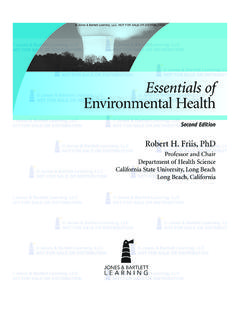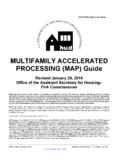Transcription of ENVIRONMENTAL IMPACT ASSESSMENT (EIA)
1 Profiles of Tools and Tactics for ENVIRONMENTAL Mainstreaming No. 1 ENVIRONMENTAL IMPACT ASSESSMENT (EIA) A product of the ENVIRONMENTAL Mainstreaming Initiative ( ) (supported by DFID and Irish Aid) International Institute for Environment and Development (IIED) 3 Endsleigh Street, London, WC1H 0DD Tel: +44-207-388-2117; Fax: +44-207-388-2826 Email: ENVIRONMENTAL IMPACT ASSESSMENT (EIA) Note: We are grateful for review comments provided by Peter Nelson (Land Use Consultants, Bristol, UK) What is EIA for? Policy development Planning Guides good decisions Field work For data collection Investment For project approval ASSESSMENT Main focus Monitoring Indicates what to monitor Campaigning What issues does an EIA focus on?
2 ENVIRONMENTAL (mainly) Social (sometimes) Economic (sometimes) Institutional (sometimes) Purpose EIA is intended to identify the impacts (both beneficial and adverse) of a proposed public and private development activities. Often, the focus is dominantly ENVIRONMENTAL (biophysical); but good practice also addresses social and economic aspects. EIA is mainly used at the level of specific developments and projects such as dams, industrial plants, transport infrastructure (eg airport runways and roads), farm enterprises, natural resource exploitation (eg sand extraction). Strategic ENVIRONMENTAL ASSESSMENT (SEA) is a sister tool applied upstream at the level of policies, plans and programmes.
3 Like SEA, EIA is most valuable when applied early in the planning process for a project as a support to decision-making. It provides a means to identify the most environmentally suitable option at an early stage, the best practicable ENVIRONMENTAL option, and alternatives to the proposed initiative; and thus avoid or minimise potentially damaging and costly negative impacts, and maximise positive impacts. Background facts EIA was first introduced in the USA under the ENVIRONMENTAL Policy Act (1969). Since then it has evolved and a variety of offshoot ASSESSMENT techniques have emerged (focusing, for example on social, biodiversity, ENVIRONMENTAL health and cumulative effects and risk) acting as a broader IMPACT ASSESSMENT toolkit.
4 Most countries have now introduced formal EIA systems, usually under dedicated ENVIRONMENTAL legislation, and have introduced EIA regulations (and often regulatory bodies) specifying when and for which developments an EIA is required, institutional responsibilities and procedures, and specific steps and processes to be followed. Brief description of the main steps involved in application of the tool: Key stages in the ENVIRONMENTAL ASSESSMENT process include: screening, alternatives, preliminary ASSESSMENT , scoping, mitigation, main EIA study and ENVIRONMENTAL IMPACT statement, review and monitoring (Box and Figure ).
5 These need to be managed so that they provide information to decision-makers at every stage of the project planning cycle (Figure ). Box 1: Steps in EIA (1) Screening (usually by an EIA Authority, or using published checklists) to decide whether an EIA is required and focus resources on projects most likely to have significant impacts, those where impacts are uncertain and those where ENVIRONMENTAL management input is likely to be Official EIA guidelines usually contain lists or schedules specifying which developments require an EIA (eg always, or in particular circumstances). (2) Consideration of possible alternatives (demand, activity, location, process & design, scheduling, inputs, no project ) should be undertaken before a choice is made.
6 Some projects can be site specific (eg in mining, extraction can only occur were a mineral is sited). In such cases the EIA might focus more on measures such as scale, mitigating measures and traffic management. Projects promoted by public sector agencies are more likely to consider alternative sites or routes for development than private sector initiatives where the early need to acquire options or purchase land strongly influences development location. (3) Preliminary ASSESSMENT - where screening suggests further ASSESSMENT is needed or if there is uncertainty about the nature of potential impacts.
7 Uses rapid ASSESSMENT techniques, but provides sufficient detail to identify key impacts, their magnitude and significance, and evaluate their importance for decision-making. Indicates if a full EIA is needed. - involving the following steps. (4) Scoping a narrowing process usually undertaken by an ASSESSMENT team to identify the key issues of concern at an early stage in the planning process and guide the development of terms of reference for the EIA. It aids site selection, identifies possible alternatives, and avoids delays due to having to assess previously unidentified possible impacts.
8 Scoping should involve all interested parties such as the proponent and planning or ENVIRONMENTAL agencies and members of the public. The results determine the scope, depth and terms of reference to be addressed within an ENVIRONMENTAL IMPACT Statement (see below). Once the site for development has been selected, the number of issues usually decreases and attention to detail increases. (5) Main EIA study building on and deepening the preceding steps to predict the extent and magnitude of impacts and determine their significance. A variety of methods can be used including: checklists, questionnaires, matrices, overlays, networks, models and simulations.
9 The study should incorporate consideration of mitigating measures - reviewing the action proposed/taken to prevent, avoid or minimise actual or potential significant adverse effects of a project, eg abandoning or modifying a proposal, or substituting techniques using BATNEEC (Best Available Technology Not Entailing Excessive Costs) such as pollution abatement techniques to reduce emissions to legal limits. If the uncertainties are great, with the possibility of grave consequences and no mitigating measures then the proposed development should be rejected. If there are uncertainties that might be reduced by further studies, then an application can be deferred pending until further studies.
10 Where mitigation is inappropriate, compensation may be an option. An ENVIRONMENTAL IMPACT Statement (EIS) is a comprehensive document that reports the findings of the EIA and now often required by law before a new project can proceed. A typical EIS, usually prepared by the project on behalf of the proponent (usually by consultants), focuses on the issues most relevant to decision-making. It can be broken down into three parts with different levels of detail: Volume 1 - a comprehensive and concise document drawing together all relevant information regarding the development project; Non-Technical Summary (NTS) - a brief report of volume 1 in non-technical language that can easily be understood by the public; Volume 2 - a volume that contains a detailed ASSESSMENT of the significant ENVIRONMENTAL effects.









